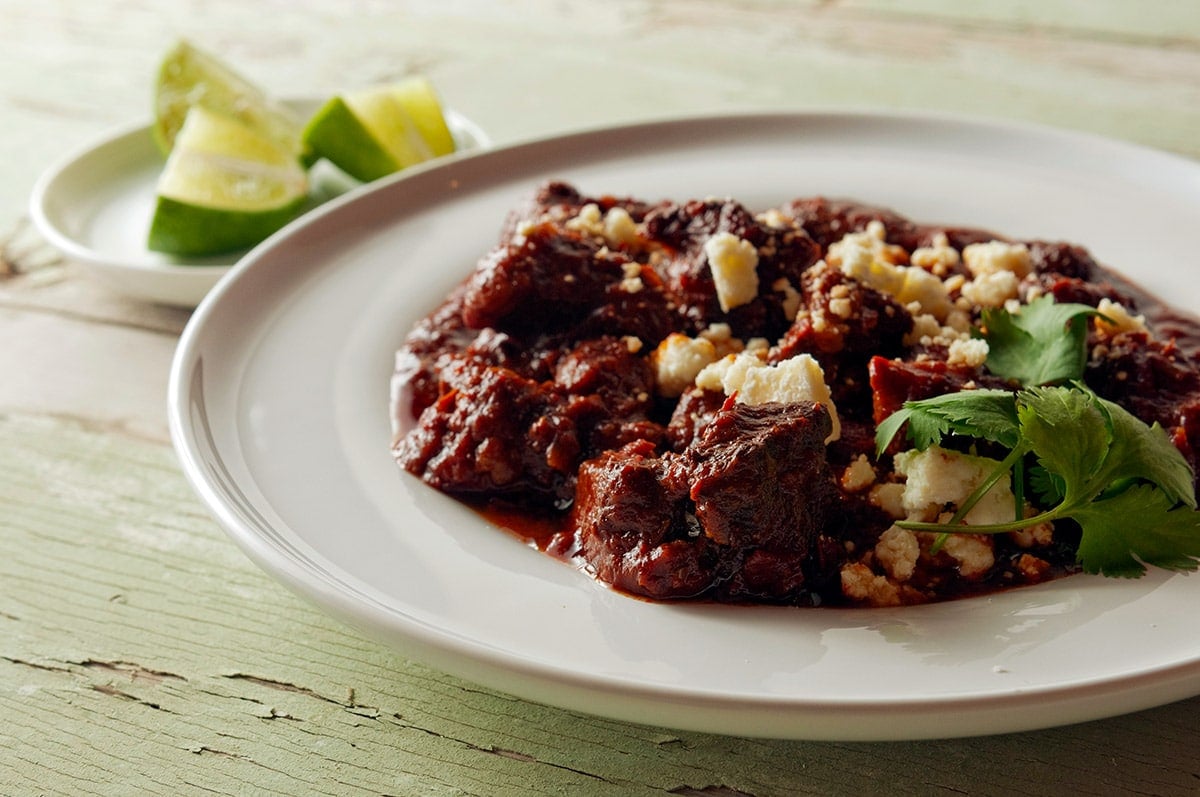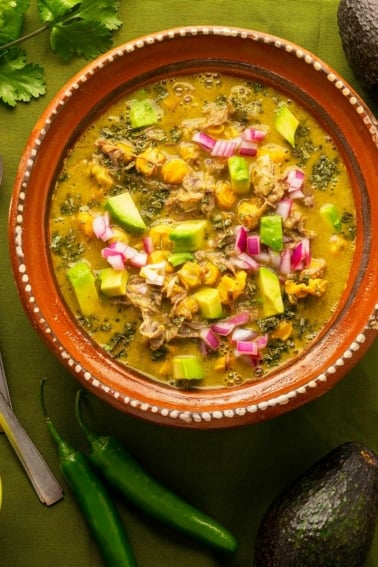As an Amazon Associate I earn from qualifying purchases.
I got an email from a reader a while back: “You should make a chile colorado recipe.” Well hell, I thought, that’s a great idea! Chile colorado, if you’ve never encountered it, is a pretty simple red chile sauce traditionally served over beef, venison or, less commonly, pork.

The origins of this sauce are unclear, but it seems to have come from the state of Chihuahua in Mexico, and has migrated up into New Mexico. There is a similar dish from Sonora called carne con chile, which I also like a lot.
“Colorado” here doesn’t refer to the state. Colorado in Spanish is, more or less, “colored red,” and is often used for blushing. I’ve also see it used specifically for the rich, dark reds of dried chiles.
For my chile colorado, dried, ripe New Mexican chiles are the most common pepper used to make it. Basically you soak dried chiles to soften them, grind them into a puree, season the sauce and simmer some tasty meat in it. Easy peasy.
Not so fast.

There is a step you need to take to make a great chile colorado: Strain out all the stray bits of chile skin. They do not puree well unless you have a badass blender. Poorly blended sauce will result in flakes getting stuck in your teeth, generally making a nuisance of themselves. And remember, pepper skins are not digestible.
Now you don’t have to strain the sauce, but it will be a lot better if you do.
Some people toast the dried chiles first. If you want to, go ahead. Just do it quickly, lest you burn the chiles, which makes them bitter. You want to see a little puffing up, not scorch marks. So do it over medium heat.
And you need not restrict your chile colorado sauce to this dish. It is a pretty good catch-all sauce, good for enchiladas, tamales, etc. I’ve had it with beef, pork and chicken at restaurants, so there is really no reason not to cook anything else in it: pheasant, turkey, bear, venison, duck — your imagination is your only limit.
And if you’d rather go green, the other big New Mexican stew is green chile stew, which, obviously, uses unripe, green chiles.
Chile Colorado
Ingredients
- 2 pounds beef, pork, venison, pheasant or turkey legs, etc.
- Salt
- 2 dried chipotle chiles (or chipotles in adobo)
- 4 dried ancho chiles
- 4 dried guajillo chiles
- 2 tablespoons lard or vegetable oil
- 2 cups chopped onion
- 5 garlic cloves, minced
- 1 quart of the appropriate stock, pork, beef, chicken, etc
- 1/2 cup crushed tomatoes
- 2 teaspoons cinnamon
- 1 tablespoon Mexican oregano
Instructions
- Cut the meat into large stewing pieces about 1 to 2 inches across. Salt well and set aside.
- Remove the stems and seeds from the dried chiles, tear them into pieces and put into a large bowl. Pour boiling water over them and cover. Let this stand until the chiles are rehydrated, about 30 minutes. Once the chiles are soft, put them in a blender with enough of the chile soaking water to make a puree the consistency of ketchup. If you want -- and I recommend this -- push the sauce through a fine-meshed strainer (into another bowl) to remove any stray seeds or bits of skin.
- In a heavy, lidded pot or Dutch oven, heat the lard over medium-high heat. Pat the meat dry with a paper towel and brown it well. Do this in batches and take your time. Remove the meat as it browns and set aside.
- Add the onions to the pot and cook them, stirring occasionally, until they just begin to brown on the edges. Add the garlic and cook another minute. Return the meat to the pot and mix in all the remaining ingredients. Bring to a gentle simmer and cook until the meat is tender.
- Serve with tortillas or over rice, garnished with queso seco, cilantro, maybe some raw onion, avocado and hot sauce.
Video
Notes
Nutrition
Nutrition information is automatically calculated, so should only be used as an approximation.





Made according to the recipe. No deviations needed – it’s perfect as is! If you are hard pressed to find dried ancho and gaujillo chiles in your local stores try Penzey’s Spices.
I’ve done this one a few times now, it’s great,. I’ve altered it a tad, I use my shanks and bone in shoulder roast and simmer it until fork tender. All that wonderful connective tissue make the sauce almost silky imo.
Went out of my comfort zone and tried it with beef. I would do it again.
Glorious in a burrito or tacos. This is among my favorite treatments for boar or venison (with some added fat on the latter). A great recipe for chili colorado every cook should have in their baxk pocket
I’ve had problems with other chile colorado recipes not penetrating into the meat – ends up just tasting like stewed cubed meat with sauce on top
any suggestions?
Ty: Nothing penetrates meat except salt. But if you cook the stew a long time, the meat will begin to fall apart, and the sauce will get into those crevices and gaps.
Thinking of using for a whitetail roast. Should I add pork fat to keep the dish from drying out?
Matthew: If it is a shoulder roast, no need. If it is a hind leg roast, I’d double the amount of lard or oil you use in cooking the stew.
Another Shank Shaw recipe that gets me out of my comfort zone. Made this last night out of elk stew meat that was planned for the grinder. Chile Colorado was a better choice than burgers or meatloaf even with the daytime high being 90F. I am enthusiastically looking forward to the leftovers for lunch. The stew was served over the cauliflower rice.
All the ingredients store well in the pantry and you probably have them laying around already. I would describe it as an easier chili recipe. Surprisingly only limited ingredients are needed. Two seasonings, allium bulbs, canned tomatoes and you can start cooking. Dried Chipotle chiles was the only item hard to find. I even went to the neighborhood taqueria/grocery to no avail. I did find a delicious torta and a dozen tamales though. I ended up using canned in adobe sauce and just used the peppers not the sauce. Still used dried ancho and guajillo chiles. The smell of cinnamon filled my kitchen as I cooked but was not overpowering in the sauce. One critique is the sauce is limited in its spiciness and depth. With it being my first taste of Chile Colorado though, that may be spot on for the dish.
Ideally, I would like the sauce a bit thicker to be easier to contain on tortillas. This could be done by simmering with the lid off near the end of your cooking time or even adding cornstarch. With no times in the recipe, one should use their own judgement.
As to those who say you will not find this in the U.S. State of Colorado, that is true because it is not a U.S. dish, it is an authentic Mexican one. The Colorado in the recipe’s name describes the color of the sauce, red; not the geographically location. I did make it in Colorado, the U.S. State, though so it is here now.
Overall, you should make this as soon as possible. It is great even during hot weather. Make it if only to add another authentic Mexican dish to your repertoire.
Thanks again for a delicious recipe Shank Shaw!